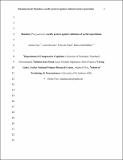Files in this item
Bonobos (Pan paniscus) vocally protest against violations of social expectations
Item metadata
| dc.contributor.author | Clay, Susanna Elizabeth Valerie | |
| dc.contributor.author | Ravaux, Lucie | |
| dc.contributor.author | de Waal, Frans B. M. | |
| dc.contributor.author | Zuberbuhler, Klaus | |
| dc.date.accessioned | 2016-02-25T17:10:11Z | |
| dc.date.available | 2016-02-25T17:10:11Z | |
| dc.date.issued | 2016-02 | |
| dc.identifier | 241227485 | |
| dc.identifier | d8114103-9850-48a5-8fe9-cf1b613c23ec | |
| dc.identifier | 84958976722 | |
| dc.identifier | 000376941500005 | |
| dc.identifier.citation | Clay , S E V , Ravaux , L , de Waal , F B M & Zuberbuhler , K 2016 , ' Bonobos (Pan paniscus) vocally protest against violations of social expectations ' , Journal of Comparative Psychology , vol. 130 , no. 1 , pp. 44-54 . https://doi.org/10.1037/a0040088 | en |
| dc.identifier.issn | 0735-7036 | |
| dc.identifier.other | ORCID: /0000-0001-8378-088X/work/64360754 | |
| dc.identifier.uri | https://hdl.handle.net/10023/8315 | |
| dc.description.abstract | Research has shown that great apes possess certain expectations about social regularities and both perceive and act according to social rules within their group. During natural and experimentally induced contexts, such as the inequitable distribution of resources, individuals also show protesting behaviors when their expectations about a social situation are violated. Despite broad interest in this topic, systematic research examining the nature of these expectations and the communicative signals individuals use to express them remains scant. Here, we addressed this by exploring whether bonobos (Pan paniscus) respond to violations of social expectations in naturally occurring social interactions, focusing on the vocal behavior of victims following socially expected and unexpected aggression. Expected aggression included conflicts over a contested resource and conflicts that were provoked by the victim. Unexpected aggression was any spontaneous, unprovoked hostility toward the victim. For each conflict, we also determined its severity and the composition of the nearby audience. We found that the acoustic and temporal structure of victim screams was individually distinct and varied significantly depending on whether or not aggression could be socially predicted. Certain acoustic parameters also varied as a function of conflict severity, but unlike social expectation, conflict severity did not discriminate scream acoustic structure overall. We found no effect of audience composition. We concluded that, beyond the physical nature of a conflict, bonobos possess certain social expectations about how they should be treated and will publicly protest with acoustically distinctive vocal signals if these expectations are violated. | |
| dc.format.extent | 838264 | |
| dc.language.iso | eng | |
| dc.relation.ispartof | Journal of Comparative Psychology | en |
| dc.subject | BF Psychology | en |
| dc.subject | NDAS | en |
| dc.subject.lcc | BF | en |
| dc.title | Bonobos (Pan paniscus) vocally protest against violations of social expectations | en |
| dc.type | Journal article | en |
| dc.contributor.institution | University of St Andrews. School of Psychology and Neuroscience | en |
| dc.contributor.institution | University of St Andrews. Institute of Behavioural and Neural Sciences | en |
| dc.contributor.institution | University of St Andrews. Centre for Social Learning & Cognitive Evolution | en |
| dc.identifier.doi | 10.1037/a0040088 | |
| dc.description.status | Peer reviewed | en |
This item appears in the following Collection(s)
Items in the St Andrews Research Repository are protected by copyright, with all rights reserved, unless otherwise indicated.

